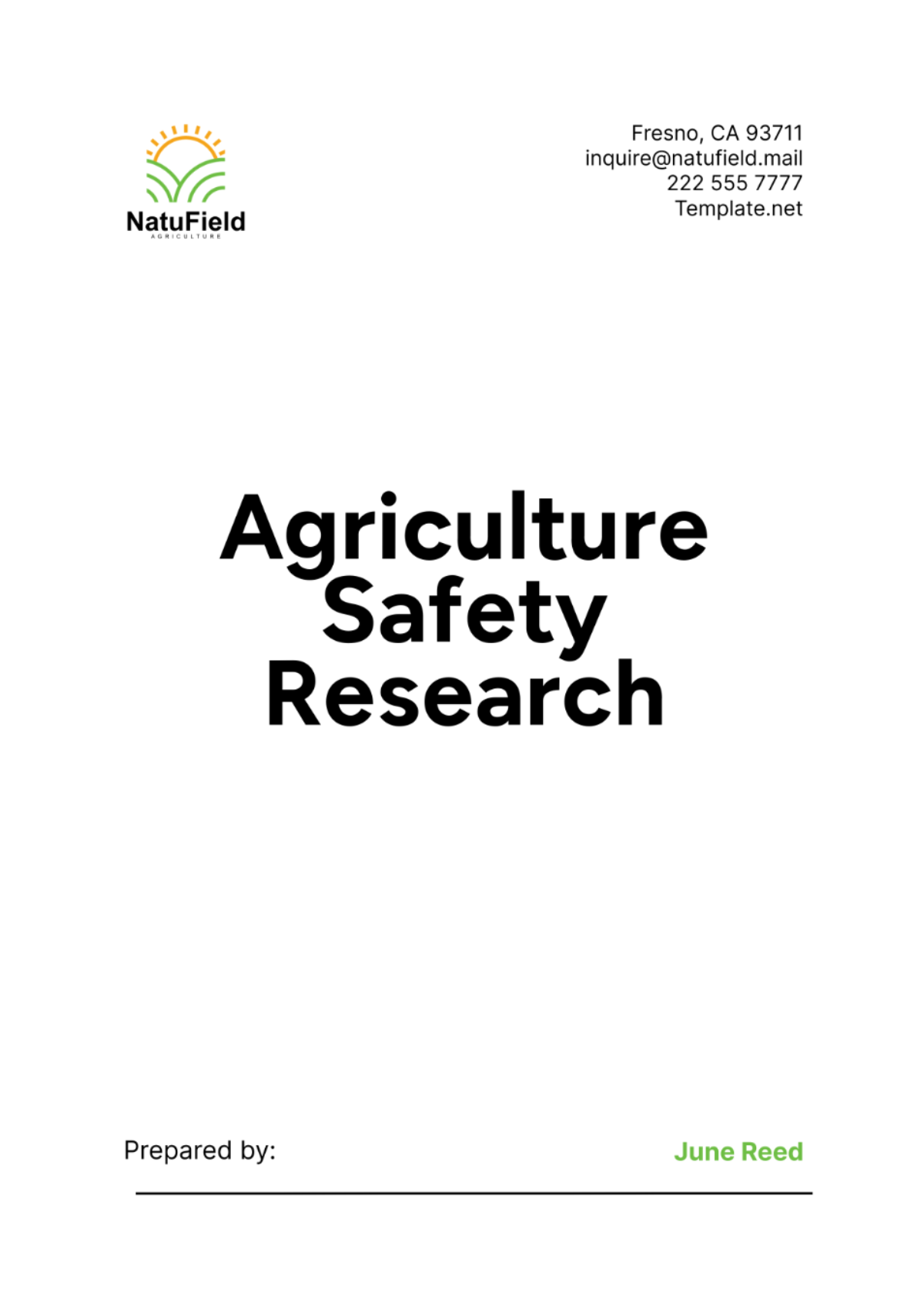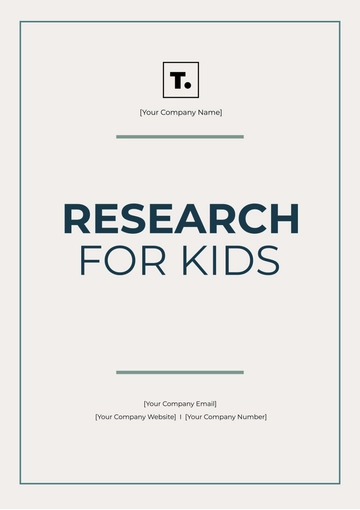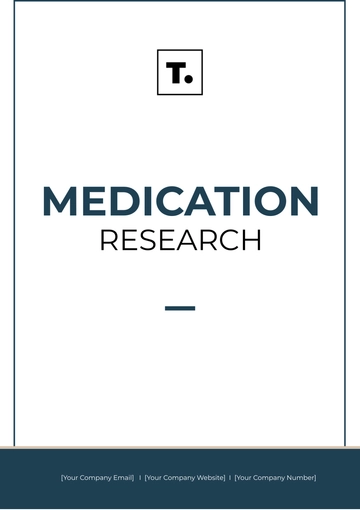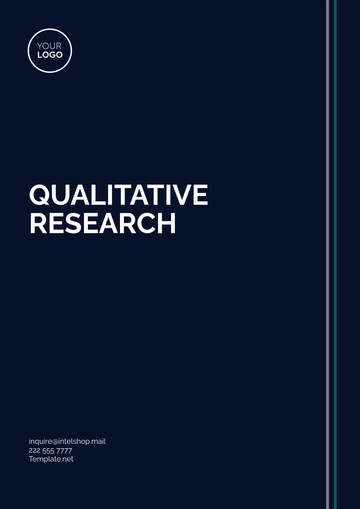Free Agriculture Safety Research

I. Introduction
Agricultural activities are integral to global food production but are accompanied by significant occupational hazards that jeopardize worker safety and well-being. According to the CDC ([Year]), the agricultural sector reports a high incidence of injuries and fatalities due to factors such as machinery accidents, chemical exposures, and ergonomic strains. Despite advancements in technology and safety regulations, these hazards persist due to the sector's dynamic and often unpredictable working environments. This research seeks to delve into current safety practices, identify prevalent risks, and propose effective strategies to enhance safety standards across diverse agricultural operations.
A. Background and Significance of Agriculture Safety Research
The agricultural sector remains one of the most hazardous industries globally, posing risks to millions of workers engaged in farming, livestock handling, and related activities. Occupational Safety and Health Administration (OSHA, [Year]) reports highlight the persistent challenges of agricultural safety, including the complex interplay of biological, chemical, and mechanical hazards in farming environments. Addressing these challenges is crucial not only for safeguarding agricultural workers but also for ensuring sustainable productivity and resilience within the agricultural economy. This study aims to contribute to the ongoing dialogue on agricultural safety by providing evidence-based insights into effective safety measures and interventions.
B. Objectives of the Study
This research aims to:
Conduct a comprehensive identification and thorough assessment of the widespread and significant safety hazards that agricultural workers are at risk of encountering in their daily work environments.
Conduct a comprehensive assessment to determine how well the existing safety protocols and interventions are performing in reducing or managing potential risks.
Develop and present a comprehensive set of practical recommendations and detailed strategies aimed at significantly improving and strengthening the safety practices and policies currently in place within agricultural environments.
Make a meaningful contribution to the comprehensive body of knowledge on agricultural safety by addressing and bridging the significant gaps that currently exist in the existing research and literature.
C. Overview of the Research Methodology
Employing a comprehensive mixed-methods approach, this study integrates quantitative surveys and qualitative interviews to capture a nuanced understanding of safety practices and perceptions among agricultural stakeholders. Surveys will be conducted among a diverse sample of 300 agricultural workers across various farm types, ensuring representation from both small-scale and large-scale operations.
In-depth interviews with 20 key stakeholders, including safety managers and farm owners, will provide qualitative insights into organizational safety cultures, barriers to safety implementation, and emerging safety challenges.
To offer a comprehensive perspective on agricultural safety practices and their implications, the process of data analysis will involve employing both descriptive statistics and thematic analysis. Specifically, descriptive statistics will be used to interpret the quantitative findings, while thematic analysis will be applied to understand the qualitative data. This dual approach aims to provide a more holistic understanding by integrating numerical data with thematic insights.
II. Literature Review
A. Overview of Current Trends and Challenges in Agricultural Safety
Recent literature underscores the multifaceted nature of agricultural safety challenges, highlighting trends such as the increasing use of automation and precision agriculture technologies alongside persistent risks like pesticide exposures and musculoskeletal injuries (NIOSH, [Year]). Climate change and evolving regulatory landscapes further complicate safety considerations in agriculture, necessitating adaptive strategies to mitigate emerging hazards.
B. Review of Previous Research and Studies on Agricultural Safety
Previous research has identified critical gaps in safety training effectiveness, particularly in addressing behavioral factors and fostering a culture of safety among agricultural workers (EHS, [Year]). Studies have also emphasized the role of organizational leadership, regulatory compliance, and technological innovations in shaping safety outcomes, providing valuable insights into best practices and challenges across different agricultural sectors.
C. Identification of Gaps in Existing Literature
Although there have been significant advancements in agricultural safety, there remain substantial gaps in our understanding of various critical aspects. Specifically, we lack comprehensive knowledge about the long-term impacts of safety interventions that have been introduced. Moreover, the influence of socioeconomic factors on safety outcomes is not yet fully understood. Additionally, the adoption and effective utilization of innovative technologies to enhance agricultural safety still present areas of uncertainty (CDC, [Year]).
Therefore, it is imperative that further research be conducted to thoroughly investigate these dimensions. Such research should aim to develop tailored strategies that can address the unique safety needs of the diverse range of agricultural operations present.
III. Methodology
A. Research Design and Approach
This study employs a cross-sectional research design to capture a snapshot of current safety practices and perceptions among agricultural workers. The approach integrates both quantitative and qualitative methods to triangulate data and provide a comprehensive understanding of safety dynamics in agriculture. By utilizing surveys and interviews, the research ensures a robust analysis of safety behaviors, attitudes, and organizational factors influencing safety outcomes.
B. Sampling Techniques and Sample Size Determination
A method known as stratified random sampling is employed to guarantee that representation is obtained from various segments of the agricultural industry. These segments encompass a range of agricultural activities, specifically crop production, livestock farming, and the cultivation of horticultural products. This approach ensures an inclusive representation by strategically dividing the population into distinct subgroups, or strata, and then randomly selecting samples from each subgroup.
In this particular study, a sample size of 300 agricultural workers, who are directly involved in the daily operations across these sectors, along with a smaller, yet significant, sample of 20 key stakeholders, who hold influential positions and decision-making power within the industry, was meticulously calculated. The determination of this sample size was guided by the objective of attaining statistical significance, which ensures that the findings are reliable and reflective of the broader population.
Additionally, this carefully chosen sample aims to capture a wide array of perspectives, thereby encompassing the varied experiences and challenges related to safety practices within the agricultural workplace. Through this comprehensive approach, the research intends to provide a well-rounded understanding of the safety practices and challenges faced by individuals within the agricultural sector.
C. Data Collection Methods
Quantitative data collection involves structured surveys administered electronically or in-person, focusing on safety knowledge, compliance with safety protocols, and perceptions of safety culture. Qualitative data collection includes semi-structured interviews with safety professionals and farm managers to explore in-depth insights into organizational safety practices, barriers to safety implementation, and opportunities for improvement.
D. Data Analysis Techniques
Data analysis employs descriptive statistics to summarize survey responses and inferential statistics to examine relationships between safety variables. Qualitative data undergo thematic analysis to identify patterns, themes, and narratives related to safety practices and perceptions. The integration of quantitative and qualitative findings enhances the validity and reliability of research conclusions, offering actionable insights for enhancing agricultural safety.
IV. Hazard Identification and Risk Assessment
A. Identification of Common Hazards in Agricultural Work Environments
Common hazards in agricultural work environments include:
Machinery Accidents: Such as entanglements in moving parts, falls from machinery, and overturns of tractors or other heavy equipment.
Chemical Exposures: From pesticides, fertilizers, and disinfectants, leading to acute poisoning or long-term health effects.
Physical Strains: Resulting from repetitive tasks, heavy lifting, and awkward postures, contributing to musculoskeletal disorders among workers.
B. Risk Assessment Methods Employed
Risk assessments utilize qualitative and quantitative approaches to evaluate hazards:
Qualitative Risk Assessment: Involves identifying hazards, assessing likelihood and severity using risk matrices, and prioritizing control measures.
Quantitative Risk Assessment: Utilizes statistical data on injury rates, exposure levels, and environmental factors to quantify risks and inform safety interventions.
C. Analysis of Risk Factors Contributing to Accidents and Injuries
Analysis reveals that inadequate training, fatigue, and time pressures are significant risk factors in agricultural accidents. Seasonal variations and weather conditions also influence risk levels, emphasizing the need for dynamic risk management strategies tailored to specific farming activities and environmental conditions.
V. Safety Interventions and Strategies
A. Overview of Existing Safety Protocols and Regulations
Existing safety protocols encompass a range of measures:
Training Programs: On safe equipment operation, chemical handling, and emergency procedures.
Personal Protective Equipment (PPE): Including gloves, eye protection, and respiratory protection to mitigate exposure risks.
Regulatory Standards: Enforced by agencies like OSHA and EPA, setting guidelines for safe agricultural practices and worker protections.
B. Evaluation of Effectiveness of Current Safety Interventions
Effectiveness varies across interventions:
PPE Usage: Shows high compliance but challenges in fit and comfort impacting consistent use.
Training Programs: Mixed outcomes due to language barriers, seasonal workforce turnover, and varying literacy levels among workers.
Regulatory Compliance: Ensures minimum standards but requires continuous enforcement and adaptation to new hazards and technologies.
C. Proposal of New or Enhanced Safety Strategies
Proposed strategies include:
Technology Integration: Implementing sensor-based technologies for real-time monitoring of hazards and worker location.
Behavior-Based Safety Programs: Focusing on cultivating safety leadership, peer accountability, and hazard reporting culture.
Collaborative Initiatives: Establishing partnerships among farmers, researchers, and policymakers to share best practices and resources, fostering a culture of continuous improvement in agricultural safety.
VI. Case Studies and Practical Applications
A. Case Studies Illustrating Successful Safety Initiatives
Successful initiatives highlight:
Farm Safety Committees: Engaging workers in hazard identification, safety training, and regular safety audits.
Safety Incentive Programs: Rewarding teams for achieving safety milestones and fostering healthy competition in adopting best practices.
Technology Adoption: Case examples of farms integrating drones for aerial surveillance or automated machinery with built-in safety features.
B. Challenges Faced in Implementing Safety Measures
Challenges include:
Cost Constraints: Especially for small-scale farms unable to invest in modern safety technologies or comprehensive training programs.
Cultural Barriers: Resisting change or misunderstanding safety protocols due to generational or cultural norms within farming communities.
Regulatory Burden: Compliance with evolving regulations while balancing operational demands and financial viability.
C. Lessons Learned and Best Practices
Key lessons include:
Leadership Commitment: Essential for fostering a culture of safety from top management to frontline workers.
Continuous Training: Tailored to address specific hazards and engage all levels of the workforce in safety practices.
Community Engagement: Collaborating with local stakeholders, extension services, and industry associations to leverage resources and support in enhancing agricultural safety.
VII. Discussion and Analysis
A. Interpretation of Research Findings
The research findings indicate that while significant strides have been made in agricultural safety, challenges persist in achieving universal compliance and addressing emerging risks. Variations in safety culture across different farm operations underscore the need for tailored interventions that consider organizational dynamics, workforce demographics, and regional agricultural practices. The study's findings also highlight the role of leadership commitment, regulatory frameworks, and technological innovations in shaping safety outcomes and fostering a proactive approach to risk management in agriculture.
B. Comparison with Existing Literature and Theories
Comparative analysis with existing literature reveals both alignment and discrepancies in safety practices and outcomes across diverse agricultural contexts. The integration of theoretical frameworks such as the Haddon Matrix for injury prevention and socio-technical systems theory provides a holistic perspective on factors influencing agricultural safety. Insights gleaned from global case studies underscore the importance of context-specific approaches and adaptive strategies in mitigating hazards and promoting sustainable safety cultures in agriculture.
C. Implications for Agricultural Safety Policies and Practices
The study's implications underscore the need for policy-makers and stakeholders to prioritize agricultural safety through comprehensive regulatory oversight, continuous education, and incentivized adoption of safety technologies. Recommendations include enhancing collaboration among industry stakeholders, investing in research-driven safety initiatives, and leveraging data analytics to monitor and mitigate emerging risks. By aligning policy frameworks with empirical evidence and stakeholder feedback, sustainable improvements in agricultural safety can be achieved to protect workers and sustain productivity.
VIII. Recommendations
A. Policy Recommendations for Improving Agricultural Safety
Policy recommendations include:
Strengthening enforcement of existing safety regulations and standards.
Introducing subsidies or tax incentives for farms investing in advanced safety technologies.
Collaborating with agricultural associations and educational institutions to develop and disseminate standardized safety training programs.
B. Practical Recommendations for Farmers and Agricultural Workers
Practical recommendations encompass:
Regular safety audits and hazard assessments tailored to specific farm operations.
Continuous training on hazard recognition, emergency response, and the proper use of PPE.
Utilization of ergonomic tools and automation technologies to reduce physical strains and enhance worker comfort and safety.
C. Suggestions for Future Research Directions
Future research should focus on:
Long-term impacts of technological innovations on agricultural safety outcomes.
Effectiveness of behavioral interventions in cultivating a safety culture among agricultural workers.
Comparative studies on safety practices and regulatory frameworks across global agricultural sectors to identify best practices and lessons learned.
IX. Conclusion
In conclusion, [Your Company Name]'s Agriculture Safety Research has provided comprehensive insights into the complex dynamics of safety in agricultural workplaces. By integrating empirical data, theoretical frameworks, and practical case studies, the study emphasizes the critical need for collaborative efforts among policymakers, industry stakeholders, and researchers to enhance safety standards and protect agricultural workers worldwide.
In the future, it will be of utmost importance to continually invest in research, education, and regulatory oversight in order to cultivate and maintain a culture of safety and resilience within the agricultural sector. Such dedicated and ongoing investments are crucial for guaranteeing both sustainable productivity and the well-being of workers who are integral to this vital area of the economy.
- 100% Customizable, free editor
- Access 1 Million+ Templates, photo’s & graphics
- Download or share as a template
- Click and replace photos, graphics, text, backgrounds
- Resize, crop, AI write & more
- Access advanced editor
Elevate your agricultural safety protocols with Template.net's Agriculture Safety Research Template. This editable and customizable document is designed to streamline your research process, ensuring thorough hazard assessments and effective safety interventions. Utilize the AI Editor Tool for seamless editing, making it easy to tailor the template to your specific needs and industry standards.





























